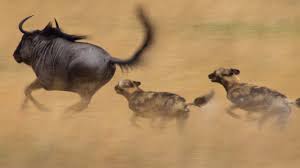Who Let The Dogs Out? Africa's Canine Soldiers Of The Bush.
When one mentions an African wild dog there is usually a shiver of revulsion, brought on no doubt by all those documentaries depicting them as the thugs of the bush.
These canines are usually shown as mangy, disease-ridden scavengers whose modus operandi when hunting, is to tear other animals to pieces and devour them when still alive. That is partly true but that’s only half the story. In my humble opinion these canine fellows have been getting a bit of a bad rap.
I recently had the opportunity to spend some time at the Matetsi Game Lodge in Northern Zimbabwe. This small camp, situated about 30 km upstream from the majestic Victoria Falls, is perched on a languid stretch of the mighty Zambezi River and is part of a sanctuary that covers a vast section of the African bush.
It comprises of just six beautifully appointed bungalows in a truly amazing setting as, just meters off shore a bloat of giant Hippopotami wallow together grunting and groaning throughout the heat off the day. Just out of reach of these massive beasts several crocodiles, their eyes just visible above the waterline wait for their unwary prey.
Matetsi was, at the time was operated by & Beyond an extremely professional outfit who, as a company certainly deliver when it comes to 'up close and personal experiences' in many parts of the world.
Game drives here are usually taken in the hour before dawn or at sunset when the African wildlife are at their busiest as the temperatures are much more bearable than the middle of the day. We were extremely fortunate on our first outing to experience first hand a pack of wild dogs demonstrating their intrepid military skill when it came to hunting.
We were stopped by a small waterhole where our ever- attentive guides offered us a sundowner while we were enveloped in the silence of the African bush at the end of a scorching day.
Suddenly, they appeared from nowhere, a pack of the mangiest creatures in the bush looking like a mob of badly dressed hooligans out for a Saturday night rumble. They seemed indifferent to our presence as they sauntered passed just 20 meters away arrogant in their own self-belief.
They stopped, looked around, took a leisurely drink, then luxuriated in the mud rolling around in the shallows and every few minutes would sit up, their ears roving like antenna listening for who knows what?
Up close these animals are not ones you would feel inclined to cuddle or indeed throw a ball for in the back yard. Their coats are a mixture every dull colour imaginable, dirty yellow, mission brown and grubby white on the tips of those pointy ears. To the casual observer they look as if they have rolled in some unspeakable offal or a pool of vomit.
Suddenly in unison they all sat bolt upright for about twenty minutes and then the entire pack, without any perceptible signal, stood as one, turned and began to trot off in single file along the vehicle tracks that traverse this 123, 000-acre stretch of bush. Our guides were more excited than we were, as this particular pack had not been sighted for almost a year.
Drinks and snacks hurriedly stored we began to follow them, driving at a steady 20 km per hour. These dogs can run all day never seeming to tire, their heads and upper bodies rigid and straight unaffected by the movement of their legs.
They travel in single file and to us observers there seemed to be no communication from the front-runner to the dog bringing up the rear. Sometimes they stop as one, to stare across the plains at herds of antelope or springbok and collectively decide that this might be too hard.
After about 40 minutes and, having covered many, many kilometers, two dogs in the rear suddenly break away from the orderly line and head off in different directions. A few minutes later two more peel off from the leading group and head to the right, again with no perceptible signal. So it continues with every few minutes two peeling off until only the leading dog is left.
Something has taken their fancy!
A large troop of baboons, preparing for their night’s rest sit about in quiet contemplation grooming each other until they realize that there is danger in the vicinity. Screeching suddenly shatters the stillness of the dusk as the baboons warn each other of a possible intrusion, it sounds as if a riot has broken out. Then, without warning from out the gloom the dogs appear at full speed from five or six angles having formed flanks around the troop who by now have grouped no together. The dogs, their prey selected, move in as one for the kill.
The largest of the male baboons will have nothing of it and stays to fight as the youngsters and mothers rush screaming for the safety of the trees. Emboldened, a number of younger male baboons form a protective barrier and screaming standoff ensues. The dogs realize that they cannot win this particular fight and retreat back to the vehicle tracks, regroup, and nonchalantly trot on once again in single file.
Within minutes they have their dinner.
Using the same tactics, they descend on a small heard of antelope the dogs descending on them from five or six different angles. The smallest and therefore the weakest antelope heard is seized by the leading dog before the rest fall upon the hapless creature and begin to tear it to shreds. They rip the flesh from the struggling antelope swallowing flesh and bone in an orgy of killing, each dog desperate to get some of the meal down its throat.
The show was not quite over as an opportunist Hyena appears skulking out of the scrub, intent on stealing the dog’s hard won work. They, like the baboons will have nothing of it. The pack turns, forms a V formation and moving forward in measured paces banishes it to the outer perimeter of their killing ground.
The crunch of bones goes on for just five minutes then, their meal complete, and not a scrap left, they regroup, give us one last arrogant stare, and disappear into the bush, no doubt to engage in their next sortie. The terrible sight we have just witnessed seemed almost surreal and out of place in the silence of the bush that has settled like a thick winter cloak.
That particular performance is repeated night after night in this wilderness mostly unseen by human eyes so I guess we were more than fortunate to witness the military like precision of the African Wild Dog and what an effective, disciplined killing machine they are. There is definitely truth in the statement,
“ Africa is not for sissies!”
Lead photo courtesy of National Geographic.



















